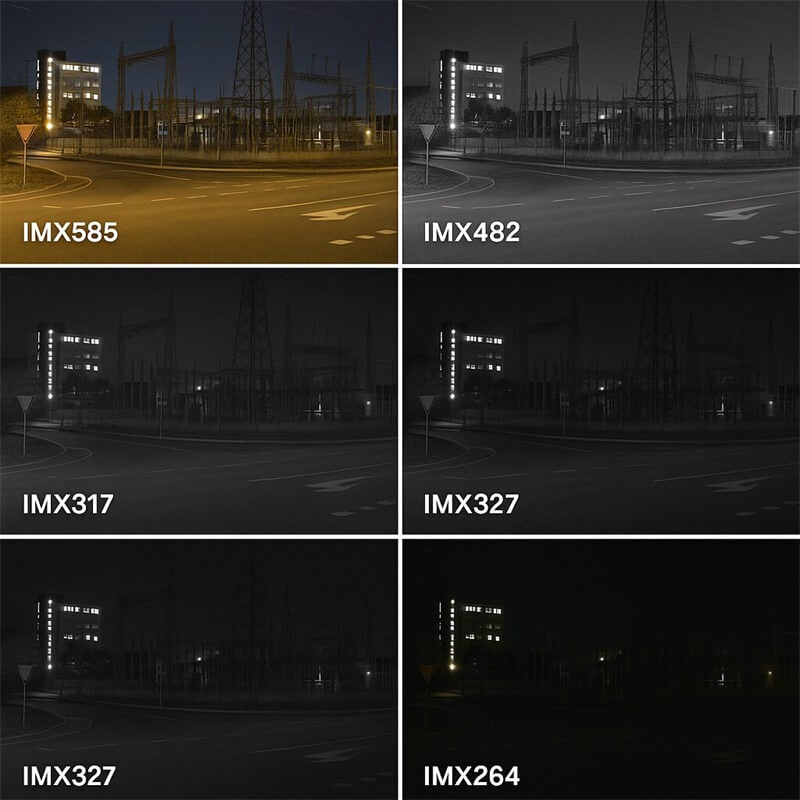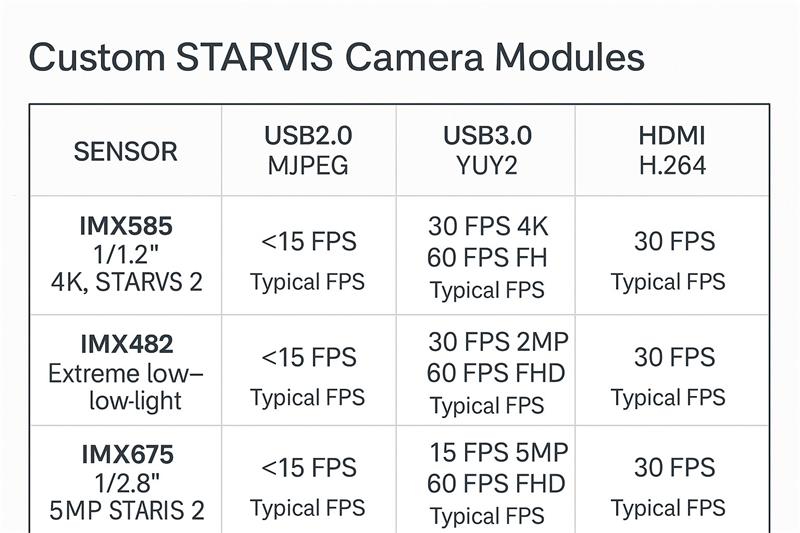
Custom night vision camera module DVP Mipi USB AHD 0.3MP to 48MP PCB FPC
Note: We had launched and are sale following Starvis starlight night vision camera module well
(1)imx291 USB camera,
(2)imx415 USB+HDMI camera module,
(3)imx335 USB3.0 camera,
(4)imx678 HDMI camera module,
(5)imx678 USB camera,
(6)imx307 USB camera,
(7)imx385 USB camera,
(8)imx462 USB camera
if you want to extend and use other Starvis cmos sensor model to custom-made 100% new personalized night vision camera module specially for your project, please read this product page carefully
Custom Sony STARVIS Camera Modules — USB / HDMI / MIPI (IMX585 · IMX482 · IMX675 · IMX317 · IMX327 · IMX264)
Featuring IMX585, IMX482, IMX675 with USB, MIPI, & HDMI Interfaces
From Sensor to Solution: Custom-Engineered Sony STARVIS Camera Modules
Your most complex imaging challenges have a solution. We specialize in developing high-performance, application-specific camera modules built on the industry-leading Sony STARVIS and STARVIS 2 sensor platforms. Whether your project demands ultimate 4K low-light performance, extreme NIR sensitivity, or a perfect balance of resolution and cost, our engineering team is ready to deliver a vision solution, not just a component.
[High-quality hero video or dynamic image here. It should showcase a variety of custom-designed modules, the engineering process (e.g., a technician working on a board), and impressive low-light performance footage.]
More Than a Manufacturer, We Are Your Vision Partner
In a market of off-the-shelf hardware, we provide a decisive advantage: deep engineering expertise and an end-to-end partnership. We enable you to build a better, more competitive product by providing a camera module that is perfectly optimized for its task.
1. Deep Sensor Expertise
We don't just read datasheets; we understand the nuanced performance of each sensor. We know that the IMX585 is the choice for unparalleled 4K vision in darkness, the IMX482 is the specialist for extreme sensitivity with its massive pixels, and the IMX675 offers the perfect blend of 5MP resolution and STARVIS 2 performance. We guide you to the right sensor to meet your performance and budget targets.
2. End-to-End Development Capabilities
Our in-house, full-stack capabilities mean we control every critical variable of your camera's performance.
3. Agile Prototyping & Scalable Production
Our agile development process is designed to accelerate your time-to-market. We move quickly from design to functional prototype for your evaluation. Once validated, our ISO 9001-certified quality management and robust supply chain ensure a seamless transition from a single unit to mass production, delivering consistent quality at any scale.

You send a short brief or use our Spec Builder. We return:
Spec Builder (what we need):
Use case (UAV/Robot/Energy) · Target sensor(s) · Interface (USB/HDMI/MIPI) · Output format (MJPEG/YUY2/H.264) · Resolution & FPS targets · Lens mount & FOV · NIR/HDR needs · Working distance/DoF · Min object size (pixels) · Host OS/CPU (Jetson/RPi/x86) · Power budget · Board size/housing constraints (32×32/38×38/custom) · Temperature/vibration · Compliance (CE/FCC/RoHS) · Quantities & timeline.
Deliverables: EVT boards, basic datasheet & pinout, UVC control map, 2D DXF & 3D STEP.
Deliverables: DVT report、revised drawings、sample footage(night/NIR/HDR)
This is an excellent selection for comparison. As of 2025, these five Sony image sensors represent a range of flagship and classic products in the security and machine vision industries. Their core differences are indeed centered on their night vision capabilities, which stem from their different technology generations, sensor sizes, and pixel designs.
Below is a detailed parameter comparison and an in-depth analysis of their night vision performance.
|
Parameter Category |
IMX585 (4K Low-Light Flagship) |
IMX482 (1080p Sensitivity King) |
IMX675 (5MP Mainstream Benchmark) |
IMX662 (1080p Technology Benchmark) |
IMX327 (1080p Classic Baseline) |
|
Core Technology |
STARVIS 2 |
STARVIS (1st Gen) |
STARVIS 2 |
STARVIS 2 |
STARVIS (1st Gen) |
|
Resolution |
8.29 MP (4K) |
2.13 MP (1080p) |
5.12 MP |
2.13 MP (1080p) |
2.13 MP (1080p) |
|
Sensor Size |
Type 1/1.2" (13.12 mm) |
Type 1/1.2" (13.12 mm) |
Type 1/2.8" (6.46 mm) |
Type 1/2.8" (6.46 mm) |
Type 1/2.8" (6.46 mm) |
|
Pixel Size |
2.9 µm |
5.86 µm (Massive) |
2.0 µm |
2.9 µm |
2.9 µm |
|
Dynamic Range Tech |
Single Exposure HDR |
DOL-HDR |
Single Exposure HDR |
Single Exposure HDR |
DOL-HDR |
|
SNR1s Index* |
Extremely Low (Top Tier) |
Extremely Low (Top Tier) |
Lower |
Low |
Standard |
*SNR1s: Sony's low-light performance index. The lower the value, the darker the environment in which the sensor can maintain a clear, usable image—meaning its night vision capability is stronger.

Our Proven 6-Step Development Process
We make custom development transparent, predictable, and efficient.
step 1 Discovery & Consultation: We begin by understanding your application, performance goals, and constraints.
step 2 Solution Architecture & Proposal: Our engineers design a technical solution and provide a detailed proposal, including specifications and project milestones.
step 3 Design & Development: Upon approval, our hardware, software, and mechanical teams begin the core engineering work.
step 4 Prototyping & Validation: We build and deliver the first functional prototypes for your in-house testing and validation.
step 5 Optimization & Client Feedback: We work collaboratively with your team to refine ISP tuning and make any necessary adjustments based on your feedback.
step 6 Mass Production & Lifecycle Support: We manage the full production lifecycle and provide ongoing technical support for your product.
Frequently Asked Questions
Q1: What is your Minimum Order Quantity (MOQ) for a custom design?
A: Our MOQ is project-dependent, but we are structured to support initial prototype runs and scale to high-volume production. Contact us to discuss your specific needs.
Q2: What is the typical lead time for first prototypes?
A: While this varies with complexity, a typical lead time for first prototypes is between 6-10 weeks after the design is finalized.
Q3: What level of technical support can we expect?
A: You will have direct access to our engineering team for support throughout the integration, testing, and production phases,
complemented by comprehensive documentation and 3D models.
Q4: What’s included in the customization process?
A: PCB design, firmware, ISP tuning, lens calibration, housing, compliance.
Q5: How long is the prototype lead time?
A: Feasibility in 48 hours, EVT boards in 6–10 weeks.
Q6: Which interfaces are available?
A: Custom starvis camera module USB HDMI MIPI options.
Q7: Do you provide datasheets and CAD files?
A: Yes, full datasheets, pinouts, DXF/STEP drawings, and test reports.
Q8: What’s your warranty and supply policy?
A: 12-month warranty, ISO 9001 production, CE/FCC/RoHS compliance, and lifecycle support with EOL notice.
Learn how to custom-made starvis usb camera guide, read this article here
https://www.okgoobuy.com/custom-starvis-usb-camera-module-guide.html
know more information about these starvis cmos sensor
Detailed Comparison of IMX585, IMX482, IMX327, IMX662, and IMX675
open and read this blog
Know our core advantage and factory, open and read here
https://www.okgoobuy.com/fac.html
Let's Build Your Next-Generation Vision System
Your project deserves more than a generic camera. It deserves a perfectly tailored vision solution. Contact our engineering team today for a free, no-obligation consultation to discuss your technical requirements and project goals.reach our engineering team directly at office@okgoobuy.com
Relative Blogs and product application Articles
1, IMX585 vs IMX678: Industrial Camera Sensor Guide
2, STARVIS sony sensor compare: IMX678 vs IMX385 vs IMX585 vs IMX327
3, Sensor Comparison: IMX678 vs IMX385 VS IMX585 VS IMX327 for Night Vision Performance STARVIS
4, STARVIS IMX307 vs IMX385 vs IMX585 vs IMX678 vs GC2053 Night Vision Performance compare
